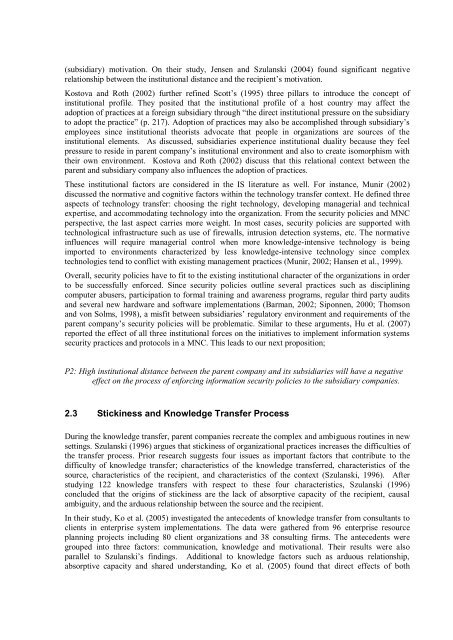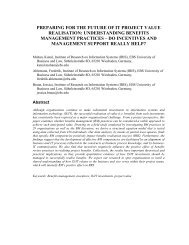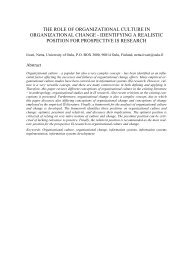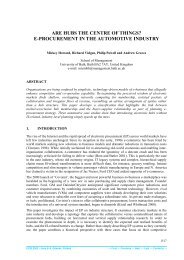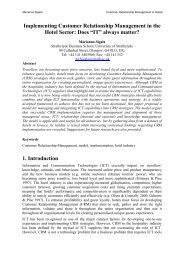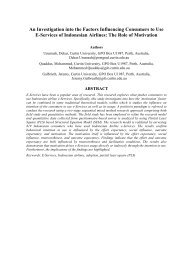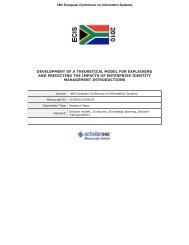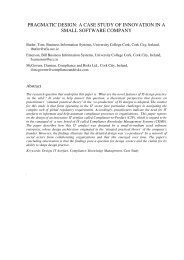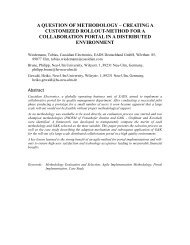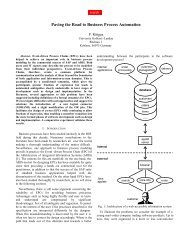enforcing information security policies through cultural boundaries
enforcing information security policies through cultural boundaries
enforcing information security policies through cultural boundaries
You also want an ePaper? Increase the reach of your titles
YUMPU automatically turns print PDFs into web optimized ePapers that Google loves.
(subsidiary) motivation. On their study, Jensen and Szulanski (2004) found significant negative<br />
relationship between the institutional distance and the recipient’s motivation.<br />
Kostova and Roth (2002) further refined Scott’s (1995) three pillars to introduce the concept of<br />
institutional profile. They posited that the institutional profile of a host country may affect the<br />
adoption of practices at a foreign subsidiary <strong>through</strong> “the direct institutional pressure on the subsidiary<br />
to adopt the practice” (p. 217). Adoption of practices may also be accomplished <strong>through</strong> subsidiary’s<br />
employees since institutional theorists advocate that people in organizations are sources of the<br />
institutional elements. As discussed, subsidiaries experience institutional duality because they feel<br />
pressure to reside in parent company’s institutional environment and also to create isomorphism with<br />
their own environment. Kostova and Roth (2002) discuss that this relational context between the<br />
parent and subsidiary company also influences the adoption of practices.<br />
These institutional factors are considered in the IS literature as well. For instance, Munir (2002)<br />
discussed the normative and cognitive factors within the technology transfer context. He defined three<br />
aspects of technology transfer: choosing the right technology, developing managerial and technical<br />
expertise, and accommodating technology into the organization. From the <strong>security</strong> <strong>policies</strong> and MNC<br />
perspective, the last aspect carries more weight. In most cases, <strong>security</strong> <strong>policies</strong> are supported with<br />
technological infrastructure such as use of firewalls, intrusion detection systems, etc. The normative<br />
influences will require managerial control when more knowledge-intensive technology is being<br />
imported to environments characterized by less knowledge-intensive technology since complex<br />
technologies tend to conflict with existing management practices (Munir, 2002; Hansen et al., 1999).<br />
Overall, <strong>security</strong> <strong>policies</strong> have to fit to the existing institutional character of the organizations in order<br />
to be successfully enforced. Since <strong>security</strong> <strong>policies</strong> outline several practices such as disciplining<br />
computer abusers, participation to formal training and awareness programs, regular third party audits<br />
and several new hardware and software implementations (Barman, 2002; Siponnen, 2000; Thomson<br />
and von Solms, 1998), a misfit between subsidiaries’ regulatory environment and requirements of the<br />
parent company’s <strong>security</strong> <strong>policies</strong> will be problematic. Similar to these arguments, Hu et al. (2007)<br />
reported the effect of all three institutional forces on the initiatives to implement <strong>information</strong> systems<br />
<strong>security</strong> practices and protocols in a MNC. This leads to our next proposition;<br />
P2: High institutional distance between the parent company and its subsidiaries will have a negative<br />
effect on the process of <strong>enforcing</strong> <strong>information</strong> <strong>security</strong> <strong>policies</strong> to the subsidiary companies.<br />
2.3 Stickiness and Knowledge Transfer Process<br />
During the knowledge transfer, parent companies recreate the complex and ambiguous routines in new<br />
settings. Szulanski (1996) argues that stickiness of organizational practices increases the difficulties of<br />
the transfer process. Prior research suggests four issues as important factors that contribute to the<br />
difficulty of knowledge transfer; characteristics of the knowledge transferred, characteristics of the<br />
source, characteristics of the recipient, and characteristics of the context (Szulanski, 1996). After<br />
studying 122 knowledge transfers with respect to these four characteristics, Szulanski (1996)<br />
concluded that the origins of stickiness are the lack of absorptive capacity of the recipient, causal<br />
ambiguity, and the arduous relationship between the source and the recipient.<br />
In their study, Ko et al. (2005) investigated the antecedents of knowledge transfer from consultants to<br />
clients in enterprise system implementations. The data were gathered from 96 enterprise resource<br />
planning projects including 80 client organizations and 38 consulting firms. The antecedents were<br />
grouped into three factors: communication, knowledge and motivational. Their results were also<br />
parallel to Szulanski’s findings. Additional to knowledge factors such as arduous relationship,<br />
absorptive capacity and shared understanding, Ko et al. (2005) found that direct effects of both


